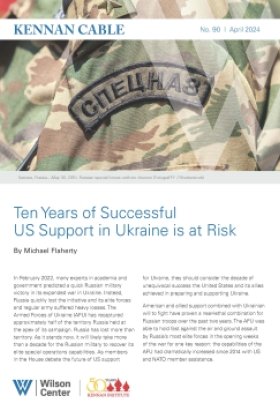Book Launch -- GULAG: A History
At a recent Kennan Institute event, Washington Post columnist Anne Applebaum discussed her new book on the system of prison camps in the Soviet Union, entitled: GULAG: A History. Applebaum emphasized that her book is not the first account of the Soviet prison system, but she noted that she was able to make use of recently opened Soviet archives to gain a more complete picture than was available to earlier authors. After giving a brief description of the GULAG and its place in the Soviet political and economic systems, Applebaum discussed why this aspect of Soviet history was ignored by most Westerners at the time, and has been so little discussed in post-Soviet Russia.
Overview
At a recent Kennan Institute event, Washington Post columnist Anne Applebaum discussed her new book on the system of prison camps in the Soviet Union, entitled: GULAG: A History. Applebaum emphasized that her book is not the first account of the Soviet prison system, but she noted that she was able to make use of recently opened Soviet archives to gain a more complete picture than was available to earlier authors. After giving a brief description of the GULAG and its place in the Soviet political and economic systems, Applebaum discussed why this aspect of Soviet history was ignored by most Westerners at the time, and has been so little discussed in post-Soviet Russia.
According to Applebaum, the first prison camps were set up by Lenin in the early years after the Revolution, but the vast system of GULAGs was a product of Stalin's rule. During his lifetime, there were a total of 467 separate camp hubs, each encompassing dozens or hundreds of sub-camps. Applebaum estimated that as many as 18 million people spent time in Stalin's GULAGs, in addition to 7 million who were sentenced to internal exile. There were camps in nearly all Soviet cities, and prison labor played a substantial role in the Soviet economy.
Although among Stalin and other Communist elites the GULAG was justified as necessary for providing cheap labor to promote Soviet industrialization, Applebaum argued that prison labor in fact was detrimental to the country's economy. Building and maintaining camps and exile cities – especially in the far north – cost far more than the total output value from the prisoners' usually low-quality labor. Relying on labor-intensive prison camps skewed Soviet economic development away from using technology and mechanization. Applebaum also pointed out that the rationale of the GULAG was not purely economic. Prisoners were subjected to a regime of intimidation and dehumanization, and living conditions in the camps were so poor that prison inspectors criticized camp directors for not keeping the prisoners in good enough health to do productive work.
Given the cruelty and pervasiveness of the GULAG, Applebaum finds it striking that the issue is so little discussed today, especially in comparison with the concentration camps of Nazi Germany. She believes that there are many reasons Russians rarely talk about the GULAG – including the length of time that has passed since the memories were fresh, the difficult economic situation in Russia, and a sense of national pride. However, the most important reason, in Applebaum's view, is that Russia's leaders (and the leaders of other post-Soviet states) have close ties to the Soviet system and do not want to have the past criticized. She sees this silence as a negative phenomenon that hinders Russia's progress of democratic reform.
Applebaum is also disappointed with the lack of awareness of the GULAG in the United States. She attributes this in part to the absence of any photographic or film images of the camps to evoke a strong emotional response. However, she also noted that the 1930s-40s were both the height of the GULAG system and the period of strongest support for the Soviet Union among Western intellectuals, who chose to ignore the atrocities. The shift to more anti-Soviet attitudes during the Cold War was caused more by political developments in the U.S. than by knowledge of Soviet wrongdoing, according to Applebaum. "It's time to stop looking at Soviet history through the narrow lens of U.S. politics and start looking at it for what it really was," she said.
Hosted By

Kennan Institute
The Kennan Institute is the premier US center for advanced research on Russia and Eurasia and the oldest and largest regional program at the Woodrow Wilson International Center for Scholars. The Kennan Institute is committed to improving American understanding of Russia, Ukraine, Central Asia, the Caucasus, and the surrounding region though research and exchange. Read more

Cold War International History Project
The Cold War International History Project supports the full and prompt release of historical materials by governments on all sides of the Cold War. Through an award winning Digital Archive, the Project allows scholars, journalists, students, and the interested public to reassess the Cold War and its many contemporary legacies. It is part of the Wilson Center's History and Public Policy Program. Read more
Thank you for your interest in this event. Please send any feedback or questions to our Events staff.










